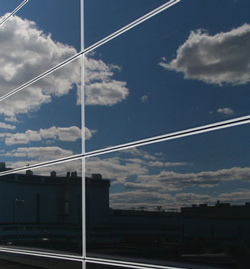- News
31 May 2011
Ruukki claims first fully integrated solar panel façade
Rautaruukki Oyj of Helsinki, Finland (which supplies metal-based components, systems and integrated systems to the construction and engineering industries under the trade name Ruukki) claims that it is the first company to develop a photovoltaic system that has been fully integrated into a solar façade. The electricity generated can either be used to meet the building’s own needs or be fed into the electricity grid.
 Based on copper indium gallium diselenide (CIGS) thin-film technology, the solar panel façade has been designed for application in buildings of a high architectural standard that comply with increasingly stricter environmental regulations, says the firm. Developed and patented by Ruukki, the system is fully integrated into the façade and is claimed to be the most cost-effective method on the market for making a fully glazed façade that generates energy from the sun. The system enables power to be produced even in areas with no direct sunlight (since the technology can also use sun rays in cloudy weather), and in snowy areas and next to water it increases output from reflected rays.
Based on copper indium gallium diselenide (CIGS) thin-film technology, the solar panel façade has been designed for application in buildings of a high architectural standard that comply with increasingly stricter environmental regulations, says the firm. Developed and patented by Ruukki, the system is fully integrated into the façade and is claimed to be the most cost-effective method on the market for making a fully glazed façade that generates energy from the sun. The system enables power to be produced even in areas with no direct sunlight (since the technology can also use sun rays in cloudy weather), and in snowy areas and next to water it increases output from reflected rays.
Picture: The solar panel façade is based on solar panels made from glazed PV modules and Ruukki’s steel rain-screen panel system.
In the façade of an average-sized office building in Finland, for example, Ruukki’s solar panel façade can produce 18,000kWh of electricity a year (enough to meet the annual needs of a medium-sized, electrically heated small-family home). Output and capacity can be increased according to the area available and the capacity required.
“The unique concept in Ruukki's solar power system is that it is fully integrated into the façade of the building, both functionally and visually,” says architect Laura Paunila at Ruukki. “The almost completely black fully glazed façade enables solutions of a high architectural standard,” she adds. No visible fastenings have been used and, due to their even colouring, the modules are more aesthetically pleasing than crystalline silicon solar panels, reckons the firm.
A solar panel façade is suited not only to office and commercial construction but also to residential and commercial construction, says the firm. The system does not limit choice of base materials or type of building, and the façade can be installed in new-build and renovation construction and on different bases, it adds.
The system is based on modular solar panels made from glazed PV modules and Ruukki’s steel rain-screen panel system. The modules are almost black in color. They can be combined with Ruukki’s other façade products and are part of its Design Palette range, which allow the size and shape of the other components in the façade to be freely defined.
A solar panel façade has a similar structure to Ruukki’s Liberta rain-screen panel façade and is installed just like an ordinary Ruukki façade. Delivery includes all the components and supplies required at the site. Also, the cabling system has been pre-designed, so on-site installation is both fast and easy, claims the firm.
